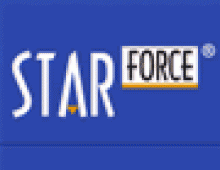
StarForce Technologies reveals StarForce Professional 3.0
Exhibitors and visitors of the international game exhibition ECTS, which takes place on August 29 - 31 in London, will be introduced to a beta version of StarForce Professional 3.0. StarForce developers integrated their cutting-edge technology of StarForce Professional 2.0, the CD-authentication process that doesn't require any 'fingerprints' on a disc's surface into their much-anticipated version 3.0...
StarForce Professional 3.0 is over 10 times superior to the well-respected version 2.0 in protection against cracking and illegitimate copying. It incorporates the unique ability to distinguish a discs' physical parameters, which allows not only controlling the licensed discs from illegal copies that are manufactured at a replication facility, but also the discs with the same title made from different daughter stampers. This distinctive feature tremendously simplifies a publishers' control over licensed CD manufacturing.
StarForce Professional 3.0 expands the protection options by introducing a brand new feature, File Protection, which is designed to protect data files that are used by the program. Additionally, StarForce Professional 3.0 offers maximum effective protection of selected functions included in the executable files by utilizing a totally new approach. Typically, protection of this kind can be done only by 'hand' modification of the source code and incorporation of protection library elements such as functions, structures, and others in this source code.
Statistics gathered by StarForce Technologies demonstrates that 97% of the game publishers don't want to deal with any source code modification to achieve the strongest level of protection for several reasons:
- 30% are afraid that the source code modification may spawn new bugs in the software.
- 40% do not want to or cannot learn the complicated documentation that describes how to work with the SDK (Software Development Kit) because of lack of time.
- 10% do not have the appropriate skills in or sufficient knowledge about programming.
- 30% do not have the source code.
As a result, the majority of protection cases are limited to the encryption of executable files, which alone may not be able to withstand professional crackers who can easily neutralize the protection and make the software available over the Internet.
StarForce Professional 3.0 allows for implementing robust protection of selected functions of the finished executable and dynamic library files utilizing the user-friendly StarForce Protection Wizard. After the developer chooses the executable and dynamic library files, which he or she wants to protect, the Protection Wizard automatically displays the file structure tree, including the complete list of all import and export functions used. The only thing left is to select functions for additional protection if so desired. During the program launch these functions become absolutely inaccessible for crackers because they are handled exclusively by the StarForceVirtual Machine and do not contain direct reference to the standard Windows API functions. These functions are often used for tracing the code algorithms by running the application under the debugger.
Therefore, by implementing StarForce Professional 3.0, a software publisher can reach the ultimate level of protection against cracking and illegal copying without having the source code handy, without thinking about what language it's written in, and what environment is was developed in. Usually it takes a long time to study an SDK for any protection but in this case it's insignificant and the efforts can be re-assigned to testing and changing the protection parameters to gain the optimal proportion: program protection/running speed.
StarForce Professional 3.0 expands the protection options by introducing a brand new feature, File Protection, which is designed to protect data files that are used by the program. Additionally, StarForce Professional 3.0 offers maximum effective protection of selected functions included in the executable files by utilizing a totally new approach. Typically, protection of this kind can be done only by 'hand' modification of the source code and incorporation of protection library elements such as functions, structures, and others in this source code.
Statistics gathered by StarForce Technologies demonstrates that 97% of the game publishers don't want to deal with any source code modification to achieve the strongest level of protection for several reasons:
- 30% are afraid that the source code modification may spawn new bugs in the software.
- 40% do not want to or cannot learn the complicated documentation that describes how to work with the SDK (Software Development Kit) because of lack of time.
- 10% do not have the appropriate skills in or sufficient knowledge about programming.
- 30% do not have the source code.
As a result, the majority of protection cases are limited to the encryption of executable files, which alone may not be able to withstand professional crackers who can easily neutralize the protection and make the software available over the Internet.
StarForce Professional 3.0 allows for implementing robust protection of selected functions of the finished executable and dynamic library files utilizing the user-friendly StarForce Protection Wizard. After the developer chooses the executable and dynamic library files, which he or she wants to protect, the Protection Wizard automatically displays the file structure tree, including the complete list of all import and export functions used. The only thing left is to select functions for additional protection if so desired. During the program launch these functions become absolutely inaccessible for crackers because they are handled exclusively by the StarForceVirtual Machine and do not contain direct reference to the standard Windows API functions. These functions are often used for tracing the code algorithms by running the application under the debugger.
Therefore, by implementing StarForce Professional 3.0, a software publisher can reach the ultimate level of protection against cracking and illegal copying without having the source code handy, without thinking about what language it's written in, and what environment is was developed in. Usually it takes a long time to study an SDK for any protection but in this case it's insignificant and the efforts can be re-assigned to testing and changing the protection parameters to gain the optimal proportion: program protection/running speed.


















